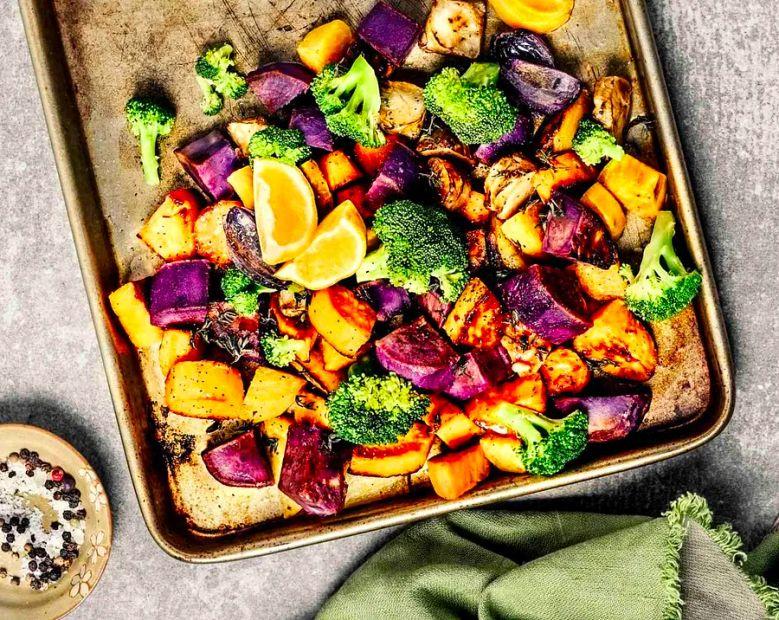The Ultimate Guide to Roasting Vegetables (Especially the Ones You’ll Actually Want to Roast)

Roasting vegetables creates a perfect balance of creamy tenderness and crisp, caramelized edges. The high heat transforms them into a mouthwatering side dish, with a smoky char or rich browning that no other cooking method can replicate.
While temperatures and cooking times may vary, the basic roasting principles remain the same for all veggies—from sweet potatoes to bell peppers. Keep this formula in mind, and you’ll be able to transform whatever vegetables you have into anything from a salad to a hearty breakfast hash.
Top Vegetables to Roast
A wide range of vegetables can be roasted to perfection. Classic root vegetables like carrots, potatoes, and parsnips are always winners. Cruciferous veggies such as Brussels sprouts, cauliflower, and broccoli also roast beautifully, as do delicate options like squash, onions, cabbage, and tomatoes.
How to Roast Your Vegetables to Perfection
Step #1: Cut or chop into even, bite-sized pieces
For quicker cooking and a better char, slice larger vegetables like potatoes and squash into smaller, uniform pieces. This increases the surface area, ensuring every bite gets that delicious caramelized crisp.
Step #2: Coat with oil and season well
You’ll want enough oil to lightly coat each vegetable piece without it pooling at the bottom of the pan. For around eight cups of veggies (about four chopped potatoes), just one to two tablespoons of oil should be perfect.
While olive oil is a great option, oils with higher smoke points are ideal for roasting at temperatures above 400°F. Avocado oil, canola oil, sunflower oil, and peanut oil can withstand these higher heats without burning, and their mild flavors won’t overpower the vegetables’ natural taste.
To ensure an even coating, don't hesitate to get your hands in the bowl. Gently toss the chopped vegetables a few times, making sure each piece is lightly coated in oil.

Step #3: Space out the vegetable pieces
Line a rimmed baking sheet with aluminum foil or parchment paper. Arrange the prepared vegetables on top, ensuring each piece has a little breathing room.
If the vegetables are too crowded, they’ll steam rather than roast, preventing that crispy, caramelized texture. While steamed veggies are tasty, they’re not the goal here.
Don’t have enough space on one pan? Grab another rimmed baking sheet and split the vegetables between them. It’s better to use two pans (the foil or parchment will make cleanup easier) than to end up with soggy, under-roasted veggies.
Step #4: High heat and a watchful eye
Preheat your oven to about 425°F. If you have time, you can go lower, around 400°F, or higher, up to 450°F. The ideal temperature depends on how much time you have and how small the vegetable pieces are.
Tiny pieces may burn too quickly at 450°F, while small pieces could take too long to cook at 400°F. 425°F is the perfect in-between temperature that ensures you get tender vegetables with that delicious caramelized char.
Roast the vegetables until you see a golden-brown crust and they’re tender enough to be pierced with a fork. Some veggies can be ready in as little as 15 minutes, so check on them every 15 minutes or so. Be sure to stir them each time to ensure even cooking and browning.

Step #5: Don’t pull them out too soon
Once you notice browning and the vegetables are fork-tender, let them cook a little longer. You want the edges to develop a nice char, so don’t rush to remove them as soon as they start to darken.
When the vegetables have reached the perfect level of caramelization, take them out of the oven and serve right away. If you leave them in a bit longer than planned, don't worry. A little extra time and browning only enhance the flavor.
How Long to Roast Vegetables
The size of your vegetables and the oven temperature (we recommend 425°F) will dictate roasting time, but these general guidelines should give you a solid starting point.
- Sweet potato – 35 minutes
- Brussels sprouts – 35 minutes
- White potato – 30 minutes
- Tomatoes – 30 minutes
- Butternut squash – 25 minutes
- Parsnip – 25 minutes
- Eggplant – 25 minutes
- Cabbage – 25 minutes
- Carrots – 20 minutes
- Broccoli – 20 minutes
- Cauliflower – 20 minutes
- Green beans – 20 minutes
- Onion slices – 15 minutes
- Bell pepper strips – 15 minutes
- Okra – 12 minutes
- Snap peas – 10 minutes
- Zucchini – 10 minutes
- Summer squash – 10 minutes
- Sugar peas – 8 minutes
How to Roast Veggies with Different Cooking Times
Different vegetables require varying cooking times. Potato cubes take longer than tender onions or peppers, and broccoli will finish cooking much sooner than butternut squash. To efficiently roast a mix of veggies, try these helpful techniques:
- Roast individual vegetables: Cook one type of vegetable at a time. You can roast potatoes by themselves, then later roast onions. Combine them when both are cooked.
- Group similar vegetables: Some vegetables have similar cook times, even if they're not quite the same. Potatoes and butternut squash, for example, cook at about the same pace. Onions and bell peppers, and broccoli and cauliflower do, too.
- Cook in steps: Cook the hardiest vegetables, like potatoes, first. Then add medium-length vegetables, like broccoli and Brussels sprouts, to the sheet pan, and cook until almost tender. Lastly, add quick-roasting vegetables like peppers and peas. Finish roasting everything all together.

1

2

3

4

5
Evaluation :
5/5